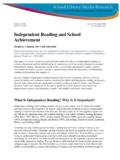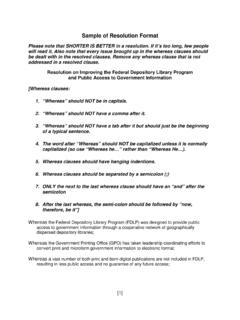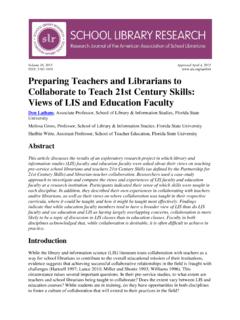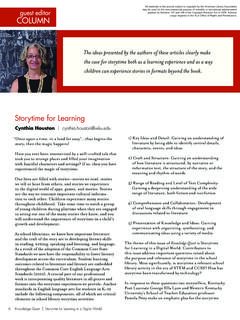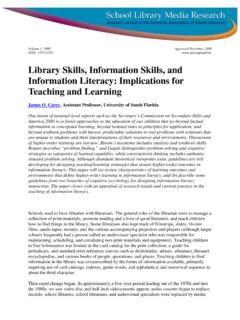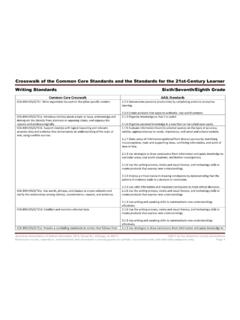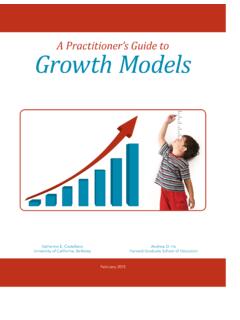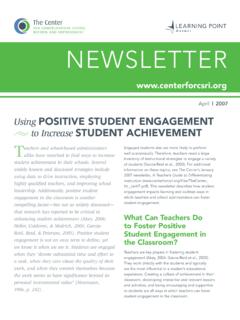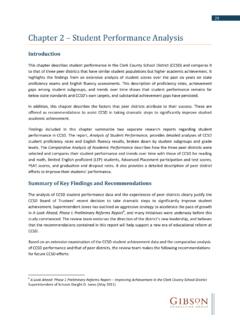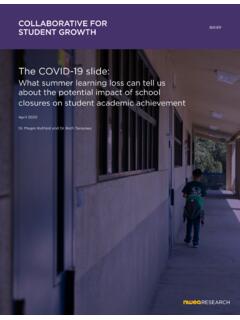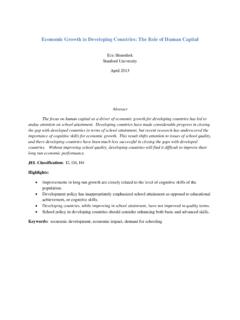Transcription of www.ala.org/aasl/slr School Librarian Staffing Levels and ...
1 Volume 15, 2012 Approved August 1, 2012 ISSN: 2165-1019 School Librarian Staffing Levels and Student achievement as Represented in 2006 2009 Kansas Annual Yearly Progress Data Mirah J. Dow, Associate Professor, Emporia State University, School of Library and Information Management Jacqueline McMahon Lakin, Education Program Consultant-Information Management, Kansas State Department of Education Stephen C. Court, Statistical Consultant Funded in part by the Kansas State Department of Education Abstract To address the presence or absence of School librarians in Kansas public schools, a study using analysis of covariance (ANCOVA) was designed to investigate Staffing Levels for library media specialists (LMSs), the label used for School librarians in licensed-personnel data in Kansas, and student achievement at the School level.
2 Five subject areas (reading, mathematics, science, history/government, and writing) were examined over a four-year period: 2006 2009. The study examined approximately million individual assessment results from 1,389 schools. Researchers found that where schools maintained higher and more stable LMS Staffing Levels , the Annual Yearly Progress (AYP) data revealed higher proficiency rates. Proficiency differences between no-LMS and full-time LMS conditions were small to moderate but critical with respect to meeting AYP targets. Effect sizes were consistent across grade spans and subject areas, and also consistent with those found in other states impact studies. The researchers recommend future studies including addressing issues of causality with stratified random samples of students using propensity-score match techniques based on logistic regression and creating indices of contribution by weighting the ANCOVA-based proficiency differences.
3 School Librarian Staffing Levels and Student achievement Volume 15 | ISSN: 2165-1019 2 School Library Research | Introduction When state legislators reduce education finances, local School boards must trim their budgets, usually by reducing or even eliminating non-classroom programs and staff. School libraries and library media specialists (LMSs), the label used for School librarians in the licensed-personnel data in Kansas, are often seen as unnecessary frills that can be cut with little effect on student learning and achievement , and with little political pushback from parents and other stakeholders. Is this an accurate perception? To respond to this critical question, an empirical study was designed and conducted to investigate the effects of Kansas LMS Staffing Levels on students proficiency rates (aggregated and assessed at the School level) on the Kansas state assessments over four years (2006 2009) in reading, math, science, history/government, and writing at the elementary, middle, and high School Levels .
4 The study tested the hypothesis that higher and more stable Levels of LMS allocation at schools will yield greater Levels of proficiency and greater positive change in proficiency when controlling for differences in prior performance, School characteristics, and student demographics. Literature Review Background on Accountability During the past five decades, education has focused on eliminating the effects of poverty through equal access to education and through established high standards and accountability. Adequate Yearly Progress (AYP), which has become well-known to all educators, is a measurement defined by the No Child Left Behind Act of 2001 (NCLB 2002) that allows the Department of Education to determine how every public School and School district in the country is performing academically, based on results of states summative assessments.
5 The standard method of determining AYP has been a status model in which School performance is mainly evaluated in terms of the proportion of students meeting or exceeding proficiency Levels on state reading and mathematics assessments. The Department of Education initiated the growth Model Pilot Project in AYP determinations under the Elementary and Secondary Education Act (ESEA 1965). growth models measure how much students have gained from one year to the next using longitudinal records of individual students achievement in reading and mathematics within three or four years or by a specific grade level (usually grade eight or nine) as defined by the state s particular growth model. For the purpose of determining AYP, students who are not proficient but are on track can be counted the same as proficient students.
6 Kansas is one of many states to explore the use of a growth model for accountability. Results from the 2010 Kansas Statewide Assessments (Kansas State Dept. of Ed. 2010) show a ten-year state-wide growth trend in reading and mathematics. Students performing in the top three performance Levels on the reading assessment increased to percent in 2010, up from percent in 2009. On the mathematics assessment, students in the top three performance Levels totaled percent in 2010, up from percent in 2009. Participation rates topped 99 percent in each subject area. This growth in Kansas has occurred in a state that has long promoted library education and employment of state-licensed School librarians. Further, Kansas educators, including School librarians, have for the past two decades used criterion-referenced assessments to indicate whether or not the test-taker performed well or poorly, to compare the test-taker s current and previous performance, and to continually revise and improve instruction.
7 School Librarian Staffing Levels and Student achievement Volume 15 | ISSN: 2165-1019 3 School Library Research | Criterion-referenced assessments used in Kansas to inform the instructional process with students include teacher-made classroom assessments, curriculum and test-coordinator-made district-level assessments, and standards-based assessments created by the Center for Educational Testing and Evaluation at the University of Kansas. School Library Research In recent years educational studies have clearly established the efficacy of state-licensed School librarians and well-funded School libraries. A series of statewide impact studies reveal tight links between students performance on assessments and School libraries with well-educated School librarians, well -funded collections, and active instructional programs in information literacy (Baughman 2000; Francis, Lance, and Lietzau 2010; Lance 2000; Lance and Hofschire 2011, 2012; Lance, Welborn, and Hamilton-Pennell 1993; Scholastic Research 2008).
8 These findings should not be surprising, given School librarians advanced preparation for partnering with classroom teachers to provide instruction, monitor progress, and make adjustments to instruction where necessary. With expertise in identifying, collecting, and organizing content and best sources of knowledge, including photographs, films, music, and presentations by experts in many languages, School librarians provide effective learning experiences while partnering with reading and other core-content-area teachers, and instructing students to use actual sources in real situations of information need (Loertscher and Woolls 2003; Zmuda 2006; Kuhlthau, Maniotes, and Caspari 2007; Long 2007; Moreillon 2007; Snyder and Roche 2008; Callison 2009; Moreillon, Hunt, and Ewing 2009; Everhart et al.)
9 2010; Mardis et al. 2010). Using strategies that reflect constructivist learning theories, School librarians develop information-literacy skills in their students. Beginning with students natural curiosity and addressing each student s interests and background experiences, ability Levels , motivation, and learning styles, School librarians and their classroom colleagues teach students to relate ideas to previous knowledge and experience, look for patterns and underlying principles, check evidence and relate it to conclusions, and cautiously and critically examine authors logic and argument. Students learn to publish and share their knowledge using the Internet, computers, and other electronic communication devices.
10 School libraries essential role in students development of information-literacy skills has also been studied and documented in the research of Barbara A. Schultz-Jones and Cynthia E. Ledbetter (2009, 2010). Through a series of studies, these researchers found that science classrooms and School libraries can be assessed along common dimensions (2010, 15). This led to the assertion that with a variety of opportunities and responsibilities for meeting the learning needs of students, School librarians can develop and nurture an optimal learning environment that makes a positive and measurable contribution to the educational process (2010, 18). School librarians ultimate goal is to partner with classroom teachers to prepare all students to share knowledge and to participate ethically and productively as members of a democratic society.
